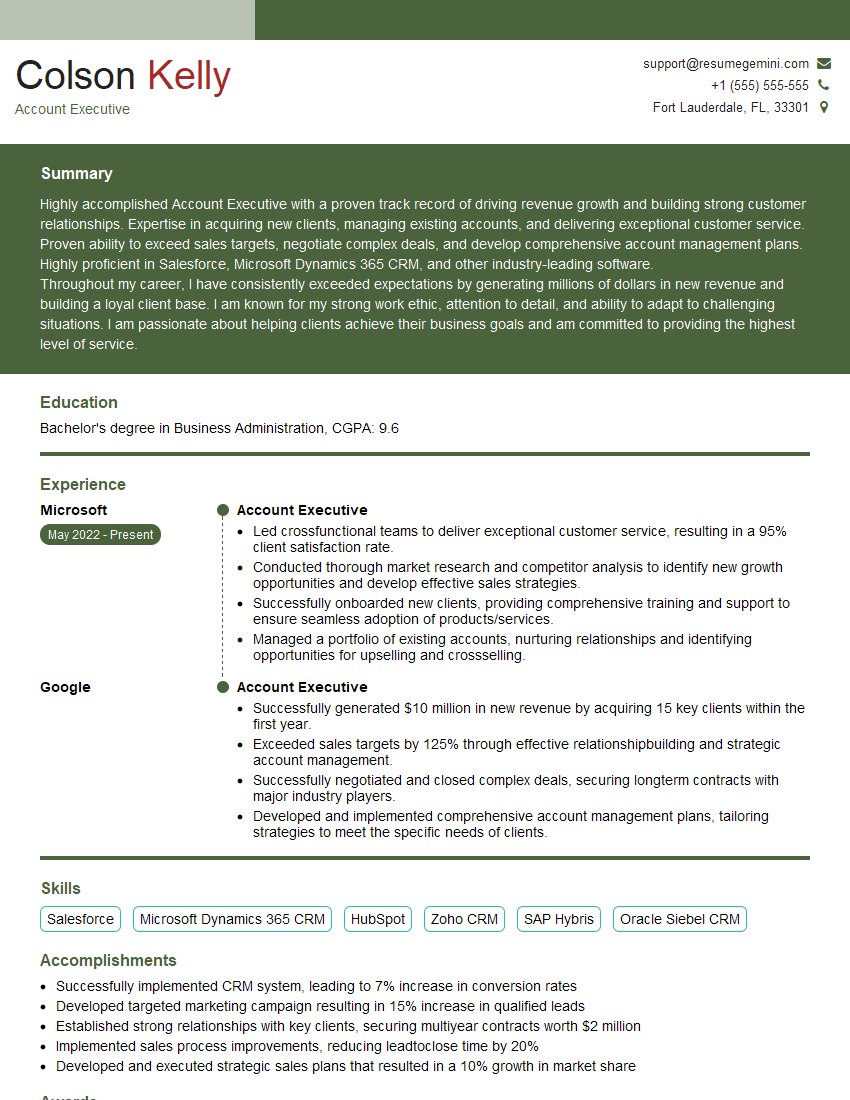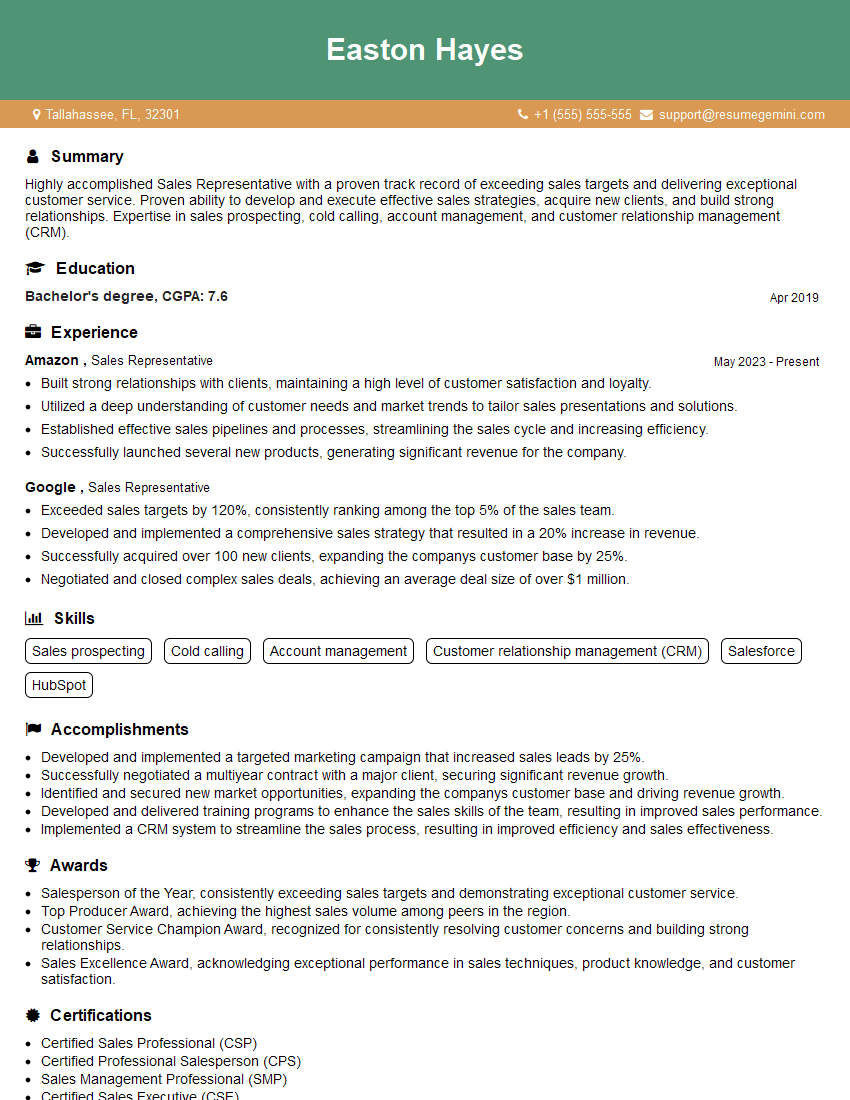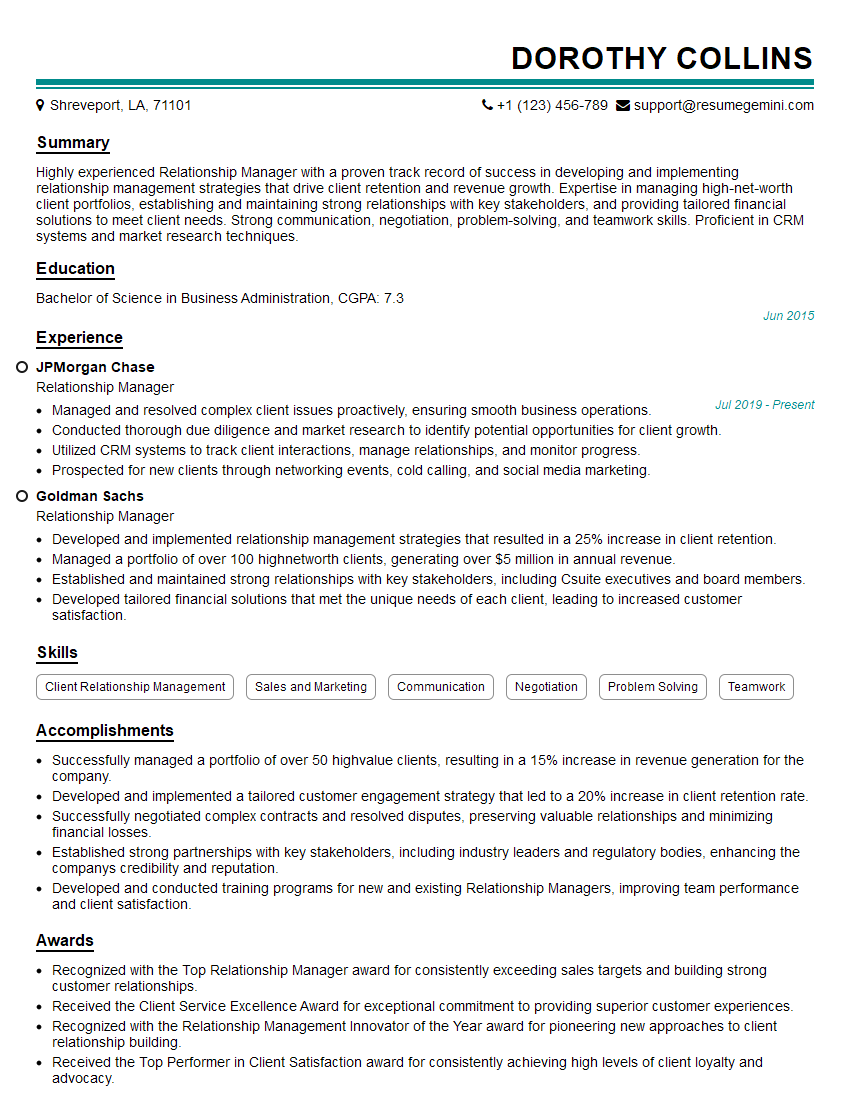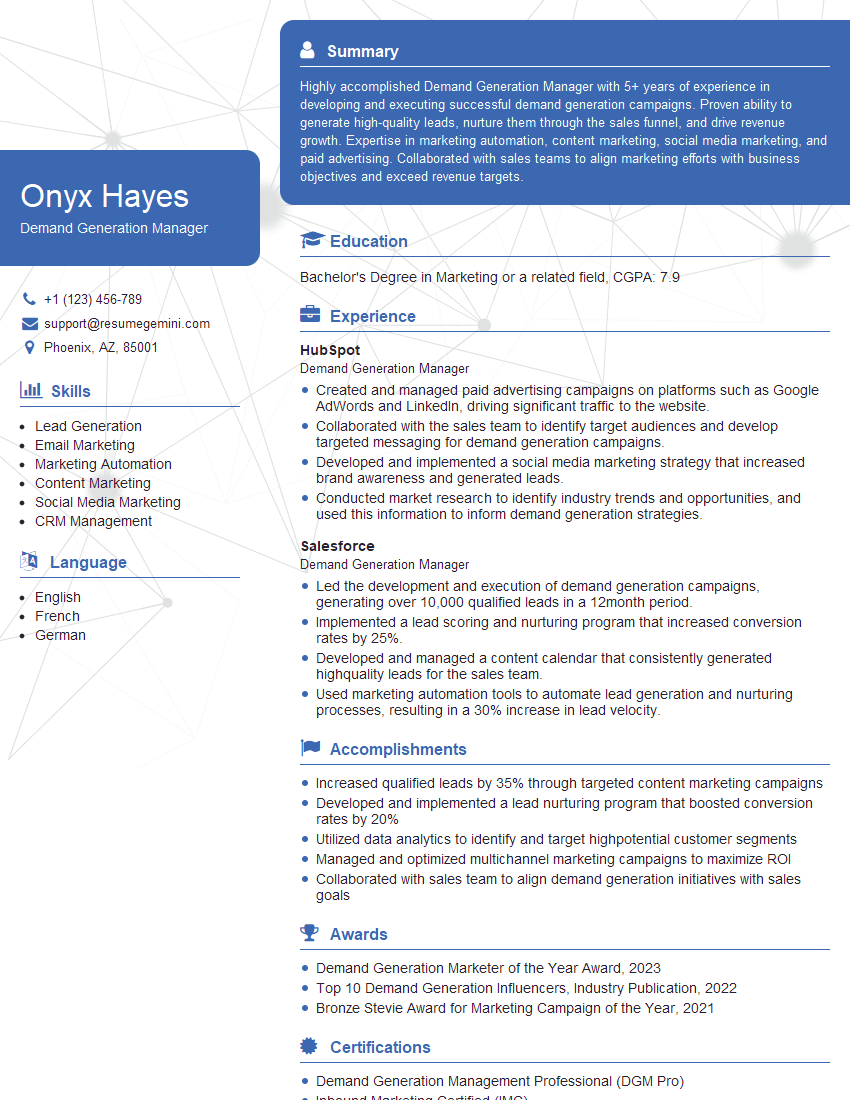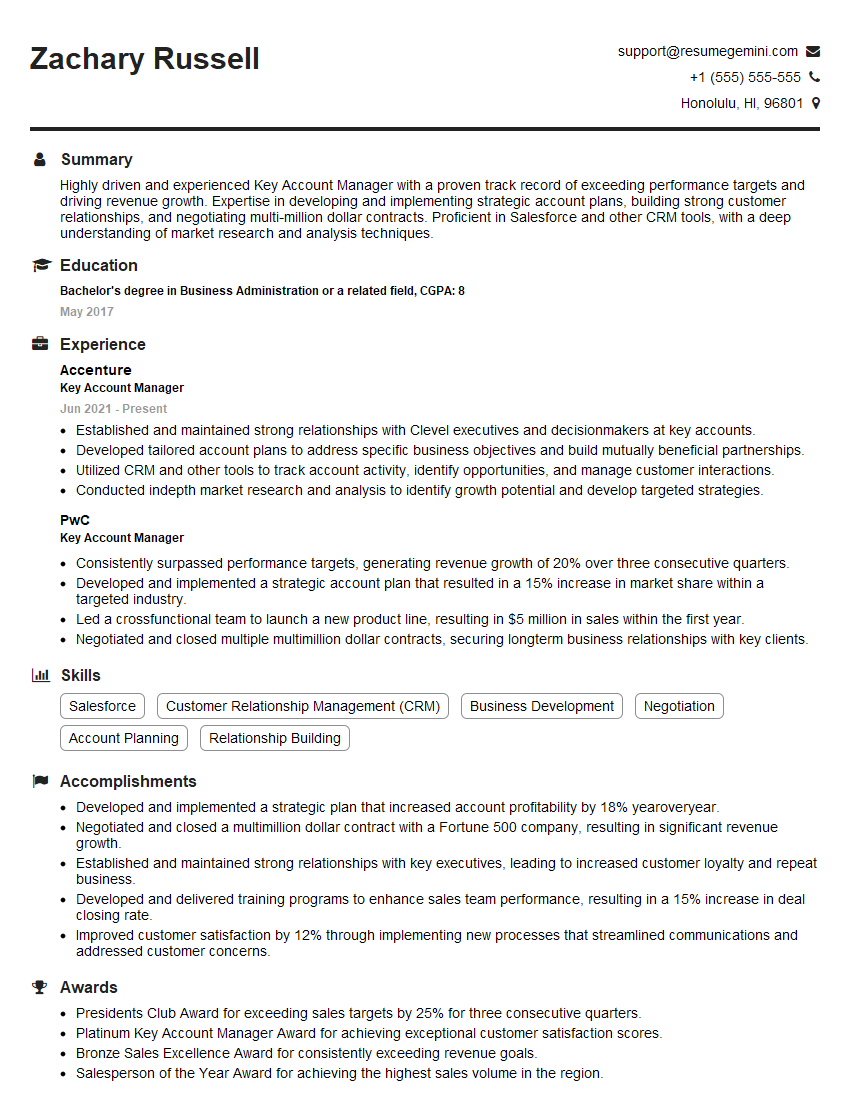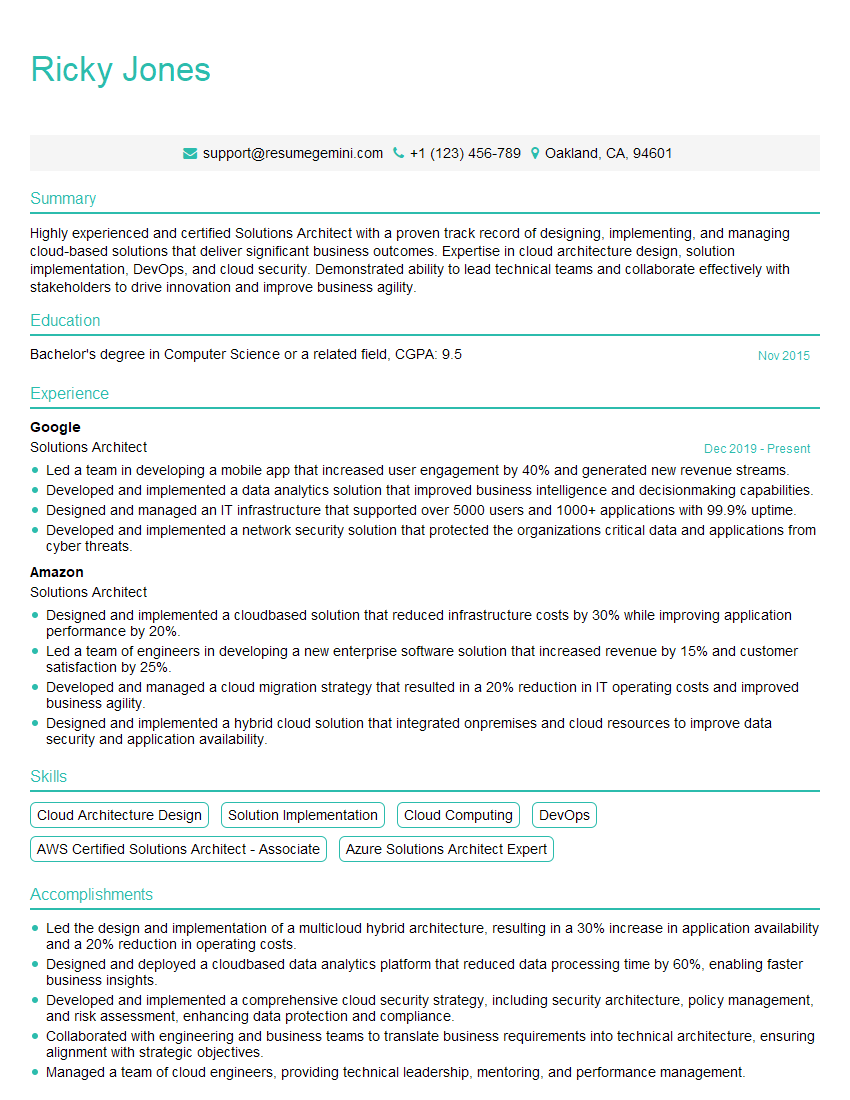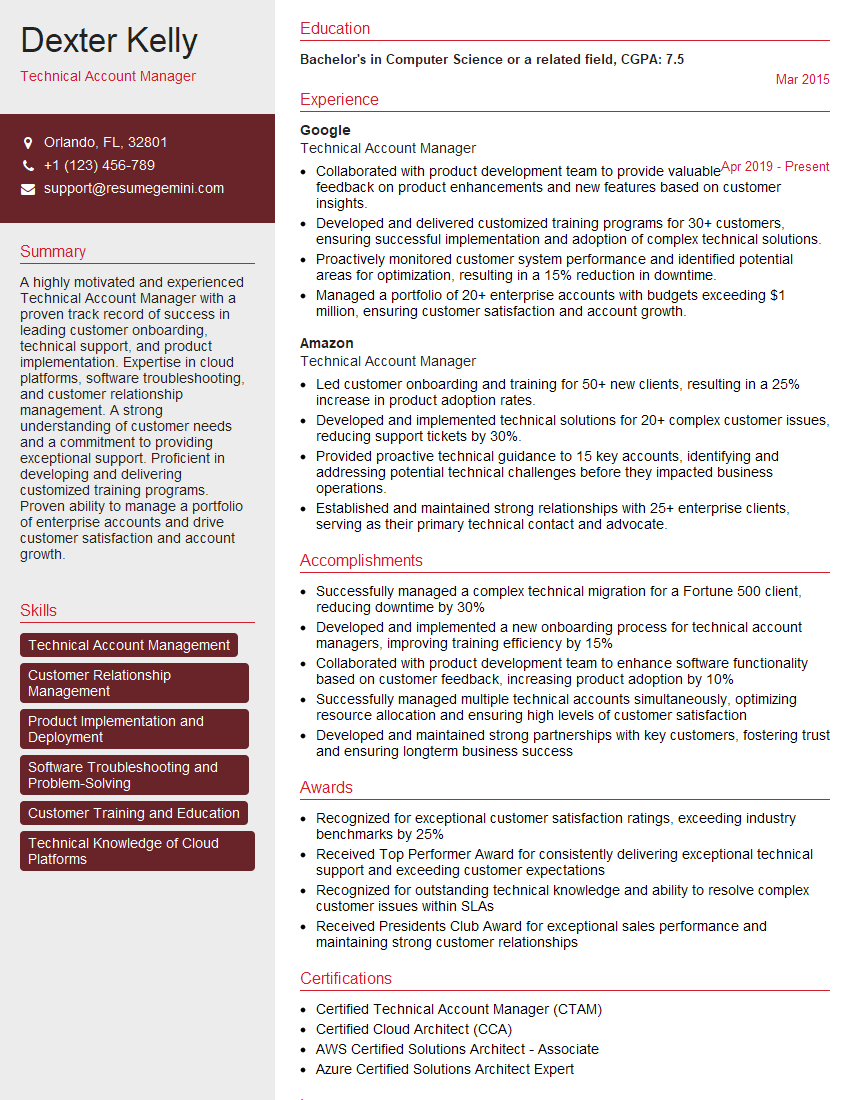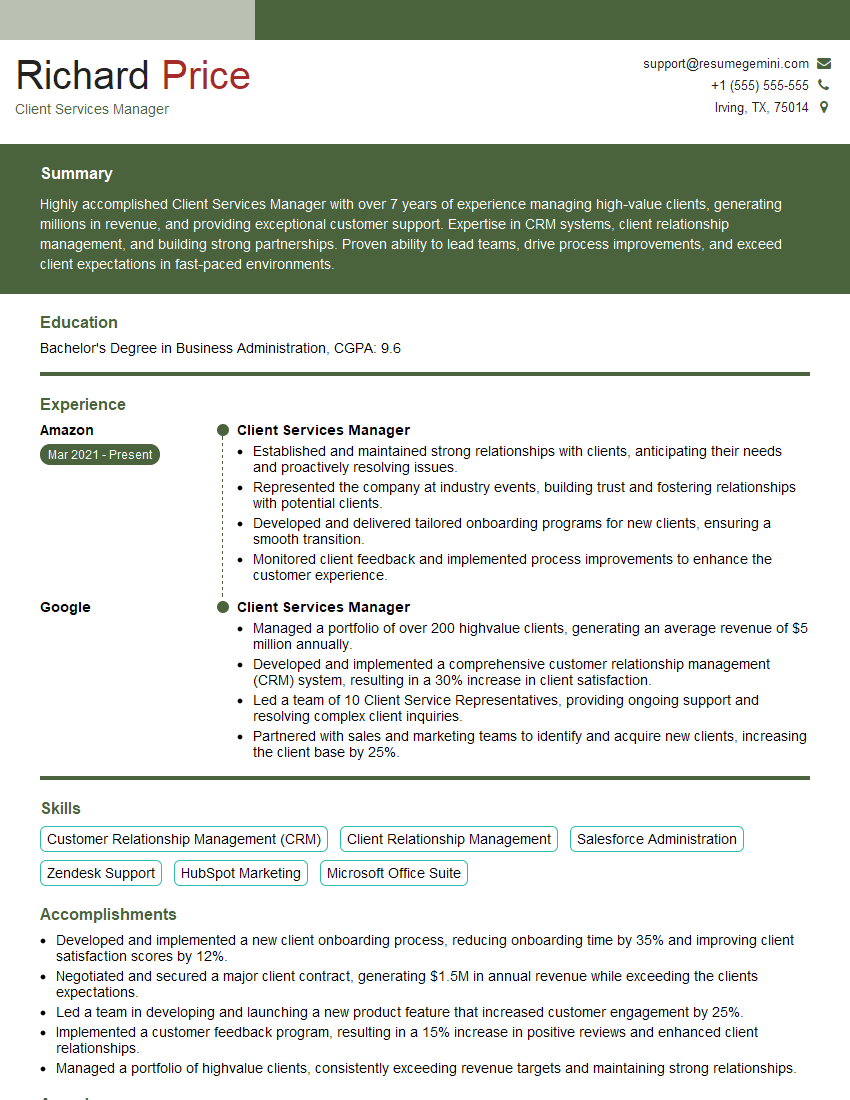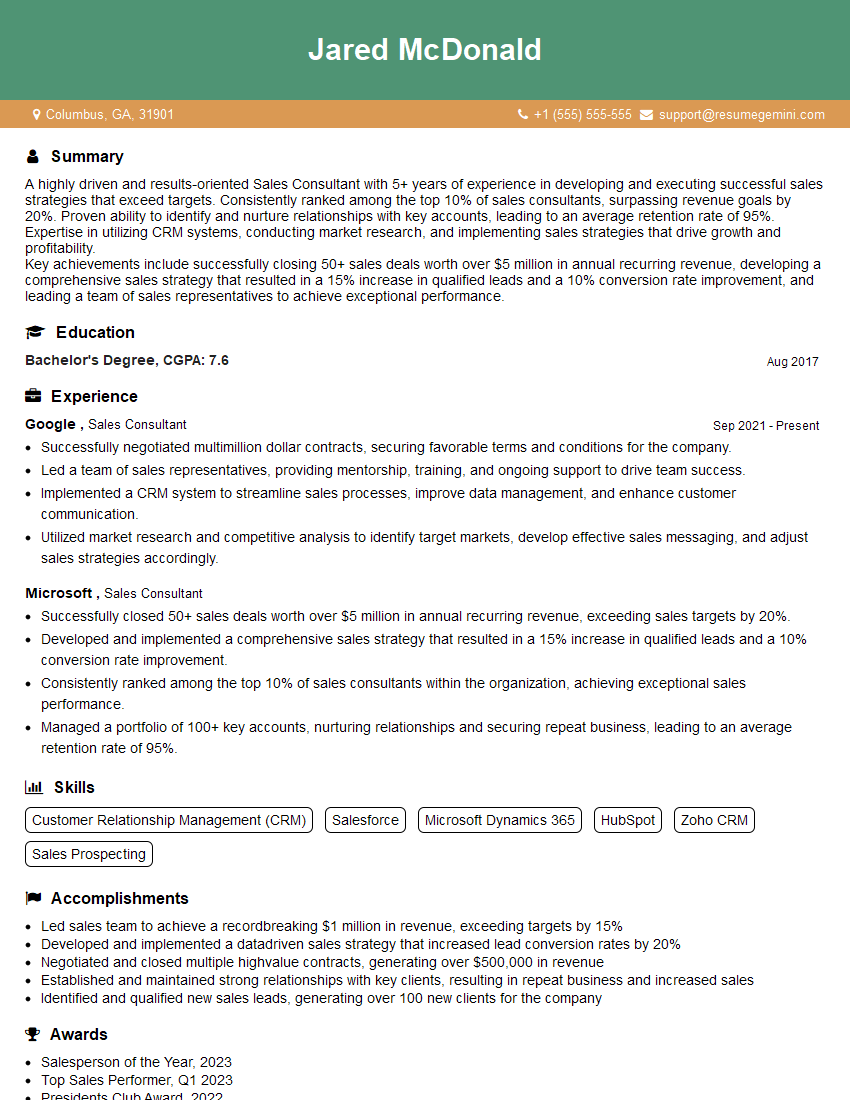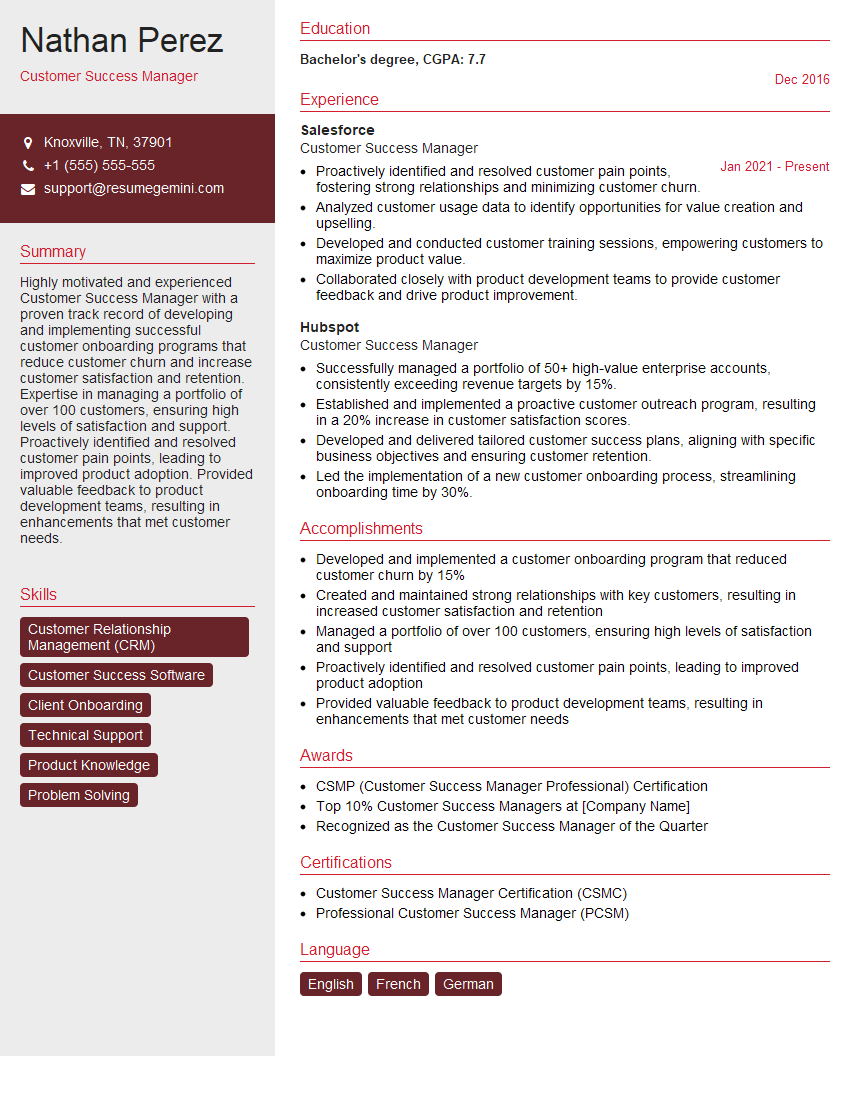The thought of an interview can be nerve-wracking, but the right preparation can make all the difference. Explore this comprehensive guide to Working with clients to determine their specific needs and preferences interview questions and gain the confidence you need to showcase your abilities and secure the role.
Questions Asked in Working with clients to determine their specific needs and preferences Interview
Q 1. Describe your process for identifying a client’s unmet needs.
Identifying unmet client needs is crucial for exceeding expectations and building strong relationships. My process involves a multi-stage approach that combines active listening, strategic questioning, and careful observation. I begin by understanding the client’s stated needs – what they explicitly tell me they require. This often involves a thorough initial consultation where we discuss their goals, challenges, and current situation. However, I don’t stop there. I actively probe deeper, using open-ended questions like, “What are your biggest frustrations with your current situation?” or “What keeps you up at night related to this project?” This encourages clients to reveal underlying concerns or unspoken needs that aren’t immediately apparent. I also observe their body language and tone, searching for inconsistencies or hesitation that might signal hidden issues. Finally, I compare their stated needs with industry best practices and market trends to identify potential gaps or opportunities they might have overlooked. For example, a client might request a simple website, but further discussion might reveal a need for enhanced SEO capabilities or e-commerce integration to truly achieve their business objectives.
Q 2. How do you prioritize competing client needs?
Prioritizing competing client needs requires a delicate balance of diplomacy and strategic thinking. I utilize a framework that combines urgency, impact, and feasibility. First, I assess the urgency of each need – which ones have immediate deadlines or critical implications? Next, I evaluate the impact of each need on the overall project goals and client success. Finally, I determine the feasibility of addressing each need within the given constraints – budget, timeline, and resources. I then use a weighted scoring system, assigning points to each need based on these three factors. Needs with high scores in all three areas are prioritized first. I present my prioritization strategy transparently to the client, explaining the rationale behind my decisions. This ensures they understand the trade-offs and feel involved in the process. Imagine a client needing both a website redesign and a marketing campaign. If the website is crucial for an upcoming product launch (high urgency and impact), while the marketing campaign can be phased, I’d prioritize the website redesign.
Q 3. Explain how you handle conflicting client requests.
Conflicting client requests are inevitable. My approach emphasizes collaborative problem-solving and clear communication. I start by acknowledging and validating each request, showing empathy for the client’s perspective. Then, I gently explore the underlying reasons behind each request to understand the client’s motivations and priorities. Often, the apparent conflict stems from a misunderstanding or a lack of awareness of the trade-offs involved. I might present alternative solutions that address both needs, albeit in a modified or phased approach. If a compromise isn’t possible, I transparently discuss the limitations and the consequences of each choice. I empower the client to make the final decision, ensuring they feel heard and in control. For instance, a client might want both a minimalist design and extensive functionality. I would present options that balance both aesthetics and usability, perhaps suggesting modular design or prioritizing core functions in the initial phase.
Q 4. How do you ensure you accurately understand client requirements?
Ensuring accurate understanding of client requirements is paramount. I employ a multi-pronged approach that involves active listening, detailed documentation, and iterative feedback loops. During meetings, I take meticulous notes and frequently summarize my understanding of the client’s requirements, encouraging them to confirm or clarify. I also utilize visual aids such as flowcharts, wireframes, and mockups to visually represent their needs and ensure we are on the same page. Before proceeding, I prepare a comprehensive document outlining the agreed-upon requirements, including specific details, timelines, and deliverables. This document serves as a shared understanding and avoids ambiguity. Finally, I incorporate iterative feedback loops throughout the project, allowing for adjustments and clarifications as the project progresses. This ensures the final product precisely meets the client’s evolving needs.
Q 5. What techniques do you use to elicit client preferences?
Eliciting client preferences involves going beyond simply asking what they want. I use a combination of techniques, including open-ended questions, visual preference tests, and case studies. Open-ended questions such as, “Tell me about your favorite websites and why you like them,” reveal deeper insights into their aesthetic preferences and functionality expectations. Visual preference tests, where I show the client examples of different designs or styles, help them identify their preferred aesthetic. Case studies showcasing successful projects can help them visualize the possibilities and articulate their preferences. Combining these methods provides a richer understanding of their preferences than a simple questionnaire could provide. This layered approach helps me understand not only *what* they like, but *why* they like it, providing crucial context for the project.
Q 6. Describe a time you had to clarify ambiguous client requirements.
In one project, a client requested a “user-friendly” interface without providing specifics. This ambiguity could lead to vastly different interpretations. To clarify, I initiated a series of follow-up meetings and asked targeted questions about their target audience, their technological proficiency, and their specific expectations for “user-friendly.” I showed them examples of various interface designs, asking them to identify elements they liked and disliked. This process revealed their preference for a clean, intuitive design with minimal clutter. We then collaboratively developed user personas to represent their target audience, which further refined our understanding of user-friendliness in the context of their specific needs. This iterative clarification ensured the final product met their implicit expectations and avoided costly revisions later on.
Q 7. How do you handle situations where client expectations are unrealistic?
Handling unrealistic client expectations requires tact, empathy, and effective communication. I start by validating their vision, acknowledging their enthusiasm, and then gently present the realities of the situation. I explain the technical limitations, budget constraints, or time restrictions that make their expectations currently unattainable. Instead of outright rejecting their ideas, I propose alternative solutions or phased approaches that gradually lead to their desired outcome. For example, if a client expects a fully functional app within a week with a very limited budget, I explain the development process, the resource requirements, and suggest a Minimum Viable Product (MVP) approach to deliver core functionality first, followed by iterative improvements. The key is to manage expectations realistically, fostering a collaborative spirit, and focusing on delivering a successful outcome within feasible parameters.
Q 8. How do you manage client expectations effectively?
Managing client expectations effectively is crucial for a positive client experience and a successful project. It involves a proactive and transparent approach, starting from the initial consultation.
- Clearly define the scope of work: From the outset, I ensure the client understands exactly what’s included in the project and, equally importantly, what’s excluded. This might involve a detailed project proposal outlining deliverables, timelines, and potential challenges.
- Set realistic expectations: I avoid overpromising and underdelivering. Instead, I present achievable goals and manage the client’s expectations based on realistic timelines and resource availability. If unforeseen delays or complications arise, I communicate them promptly and transparently.
- Regular communication: Consistent updates, whether through regular meetings, email correspondence, or progress reports, keep clients informed and engaged. This prevents misunderstandings and allows for early intervention if expectations begin to diverge.
- Document everything: A well-maintained record of all agreements, discussions, and changes serves as a reference point for both myself and the client. This mitigates disputes and reinforces transparency.
For example, if a client expects a website to be ready within a week, and I know this is unrealistic due to design, development, and testing phases, I’ll clearly explain the necessary steps and propose a more realistic timeline, perhaps two to three weeks. This transparency builds trust and avoids disappointment later.
Q 9. How do you document client needs and preferences?
Documenting client needs and preferences is paramount for delivering a service tailored to their specific requirements. I utilize a multi-faceted approach that blends formal documentation with informal note-taking to capture the full picture.
- Requirement gathering sessions: Structured meetings or interviews are held to thoroughly explore client needs, focusing on their goals, objectives, and desired outcomes. Questions are open-ended to encourage detailed responses.
- Surveys and questionnaires: These can be particularly useful for gathering information from multiple stakeholders or for collecting standardized data about preferences.
- Detailed project briefs: These formal documents summarize the client’s requirements, including specific details, deadlines, and key performance indicators (KPIs).
- Meeting minutes: A record of all key discussions, including decisions made and action items assigned, ensures accountability and transparency.
- Visual aids: Mood boards, style guides, and wireframes help capture visual preferences and concepts early in the process.
For instance, if designing a logo, I’d document the client’s preferred color palettes, fonts, and stylistic preferences, along with their business’s mission and target audience. This detailed record helps ensure the final product aligns perfectly with their vision.
Q 10. How do you use client feedback to improve your service?
Client feedback is invaluable for continuous improvement. I actively solicit and utilize feedback to refine my services and ensure client satisfaction.
- Regular feedback mechanisms: I incorporate multiple avenues for feedback, including post-project surveys, mid-project check-ins, and informal feedback channels (e.g., email, phone calls).
- Analyzing feedback: I systematically review all feedback, identifying recurring themes and patterns. This helps pinpoint areas needing improvement.
- Implementing changes: Based on the analysis, I implement necessary changes to my processes, methodologies, or service offerings.
- Tracking improvements: I monitor the impact of implemented changes by tracking key metrics such as client satisfaction scores and project completion rates.
For example, if consistent feedback points to a lack of clarity in my project proposals, I might rewrite the templates to be more concise and user-friendly. This iterative approach based on real client feedback is key to ongoing improvement.
Q 11. Explain your approach to active listening during client interactions.
Active listening is more than just hearing; it’s about fully understanding the client’s message, both verbal and nonverbal. My approach involves several key components:
- Paying attention: I focus entirely on the client, minimizing distractions and giving them my undivided attention. Body language communicates attentiveness: maintaining eye contact, nodding, and using open postures.
- Withholding judgment: I listen without interruption or forming preconceived notions, allowing the client to express their thoughts and feelings freely.
- Reflecting and clarifying: I regularly summarize or paraphrase what the client has said to confirm my understanding and ensure there are no misinterpretations. Asking clarifying questions helps delve deeper into their needs.
- Empathy and understanding: I strive to understand the client’s perspective and feelings, even if I don’t necessarily agree with their viewpoints. This empathy fosters trust and open communication.
For example, if a client expresses frustration about a delay, instead of immediately jumping to solutions, I’d first acknowledge their feelings, saying something like, “I understand your frustration with the delay; it’s certainly inconvenient.” Then I would actively listen to their concerns before offering solutions.
Q 12. How do you build rapport with clients to facilitate open communication?
Building rapport is fundamental for establishing trust and facilitating open communication. I achieve this by focusing on genuine connection and understanding.
- Building personal connections: I make an effort to learn about the client beyond their professional role. A brief, informal conversation about shared interests or experiences can help build a more personal connection.
- Active listening (as described above): Showing genuine interest in what the client has to say fosters trust and mutual respect.
- Clear and concise communication: Using simple language, avoiding jargon, and being responsive to inquiries demonstrates professionalism and respect for the client’s time.
- Being reliable and dependable: Consistent follow-through on commitments and promises builds credibility and trust.
- Showing appreciation: Expressing gratitude for their business and acknowledging their contributions reinforces the positive relationship.
For instance, I might start a meeting by asking about a client’s recent vacation or a project they’re excited about, demonstrating a genuine interest in their life beyond the immediate project. These seemingly small gestures can make a significant difference.
Q 13. How do you identify and address client concerns proactively?
Proactive identification and addressing of client concerns minimizes potential issues and strengthens the client relationship. My strategy involves:
- Regular check-ins: Scheduled check-in meetings or calls provide opportunities to gauge client satisfaction and address any emerging concerns early on.
- Monitoring progress: Closely tracking project progress against milestones and timelines helps identify potential roadblocks before they become significant problems.
- Seeking feedback proactively: Regularly asking for feedback, not just at the end of a project, allows for early detection of dissatisfaction or potential misunderstandings.
- Transparency and communication: Keeping clients informed about progress, challenges, and potential changes prevents surprises and allows for collaborative problem-solving.
- Developing contingency plans: Anticipating potential risks and developing contingency plans ensures a smooth workflow even when unforeseen issues arise.
For example, if I notice a client’s emails are becoming less frequent or their responses are shorter than usual, I might proactively reach out to inquire about any concerns they might have. This demonstrates attentiveness and shows I value their business.
Q 14. How do you translate client needs into actionable plans?
Translating client needs into actionable plans requires a structured approach that ensures clarity, feasibility, and alignment with the client’s objectives.
- Define clear objectives: Collaboratively define specific, measurable, achievable, relevant, and time-bound (SMART) objectives that address the client’s needs.
- Break down tasks: Decompose large projects into smaller, manageable tasks with assigned responsibilities and deadlines.
- Develop a timeline: Create a realistic project timeline that outlines key milestones and deliverables.
- Allocate resources: Identify and allocate necessary resources, including personnel, budget, and technology.
- Establish communication channels: Define how communication will flow throughout the project, including regular meetings, updates, and feedback mechanisms.
- Develop a risk management plan: Identify potential risks and develop mitigation strategies to minimize their impact.
For instance, if a client needs a new marketing campaign, the actionable plan would include specific tasks like market research, content creation, media selection, budget allocation, and performance tracking with clearly defined timelines and responsibilities. This detailed plan ensures everyone is on the same page and the project stays on track.
Q 15. Describe your experience using client relationship management (CRM) systems.
My experience with CRM systems is extensive, spanning several years and various platforms, including Salesforce, HubSpot, and Zoho. I’m proficient in utilizing CRM systems not just for data entry but for strategic client relationship management. I leverage them to track interactions, manage communication, identify opportunities, analyze client behavior, and forecast sales. For example, in a previous role, I used Salesforce to segment our client base based on purchase history and engagement levels, enabling targeted marketing campaigns that significantly improved conversion rates. Beyond data management, I use CRM systems to proactively identify potential issues and anticipate client needs, fostering stronger, more profitable relationships.
Specifically, I’m skilled in using CRM functionalities like:
- Lead management: Qualifying leads, assigning them to appropriate team members, and tracking their progress through the sales pipeline.
- Contact management: Maintaining detailed records of client interactions, including notes from calls and emails.
- Opportunity management: Tracking potential deals, forecasting revenue, and monitoring progress towards closure.
- Reporting and analytics: Generating reports to track key metrics such as customer lifetime value (CLTV) and sales performance.
Career Expert Tips:
- Ace those interviews! Prepare effectively by reviewing the Top 50 Most Common Interview Questions on ResumeGemini.
- Navigate your job search with confidence! Explore a wide range of Career Tips on ResumeGemini. Learn about common challenges and recommendations to overcome them.
- Craft the perfect resume! Master the Art of Resume Writing with ResumeGemini’s guide. Showcase your unique qualifications and achievements effectively.
- Don’t miss out on holiday savings! Build your dream resume with ResumeGemini’s ATS optimized templates.
Q 16. How do you handle difficult or demanding clients?
Handling difficult or demanding clients requires a calm, empathetic, and solution-oriented approach. My strategy involves active listening to fully understand their concerns, validating their feelings, and then collaboratively working towards a resolution. I avoid getting defensive or taking things personally. Instead, I focus on finding common ground and reframing the situation in a positive light. For instance, I once had a client who was extremely frustrated by a delay in a project. Instead of arguing the points, I acknowledged their frustration, apologized for the inconvenience, and proactively offered solutions – expediting certain tasks, providing regular updates, and even offering a small compensation for the delay. This approach transformed a very angry client into a loyal one, highlighting the power of empathy and proactive problem-solving. Ultimately, clear communication, patience, and a willingness to compromise are key.
Q 17. How do you tailor your communication style to different client personalities?
Adapting my communication style to different client personalities is crucial. I believe in understanding their communication preferences – some clients prefer concise, data-driven updates, while others require more detailed explanations and a personal touch. I pay close attention to their body language and verbal cues to gauge their comfort level. For instance, with a detail-oriented client, I’ll provide comprehensive reports and anticipate potential questions. With a more direct client, I’ll get straight to the point and offer clear, actionable solutions. I find that mirroring their communication style (to a certain extent) builds rapport and trust, leading to more effective collaboration.
Q 18. How do you ensure that all stakeholders’ needs are considered?
Ensuring all stakeholders’ needs are considered requires a proactive and collaborative approach. I utilize several strategies to accomplish this. Firstly, I hold regular meetings with all involved parties – clients, internal teams, and even external vendors if applicable – to gain a holistic understanding of everyone’s requirements and expectations. I use tools like shared project management platforms (e.g., Asana, Trello) to maintain transparency and keep everyone informed of project progress. Furthermore, I create detailed project plans that outline responsibilities, timelines, and deliverables, ensuring that everyone is aligned and knows their role. Open communication and active listening are key to anticipating and addressing any potential conflicts or misalignments early on. Essentially, I act as a central point of communication, coordinating all activities to ensure a smooth and efficient process that meets the needs of all parties involved.
Q 19. Describe a time you successfully negotiated a solution that met both client and company objectives.
In one project, a client had an ambitious deadline that seemed impossible to meet given our team’s current workload. The initial proposal wouldn’t meet their timeline, and the company was hesitant to compromise on quality. Through negotiation, I proposed a phased approach. We agreed to deliver a core set of features by the client’s initial deadline, and then deliver the remaining functionalities in a subsequent phase. This allowed us to meet their immediate need without compromising on the overall product quality. The client appreciated our flexibility and proactive approach, strengthening our relationship and leading to future business opportunities. This win-win situation demonstrated the power of creative solutions and open communication in achieving both client satisfaction and company objectives.
Q 20. How do you quantify the success of meeting client needs?
Quantifying the success of meeting client needs involves using both qualitative and quantitative metrics. Quantitatively, I track metrics like client satisfaction scores (CSAT), Net Promoter Score (NPS), project completion rates on time and within budget, and revenue generated from the client. Qualitative measures include client feedback gathered through surveys, informal conversations, and formal reviews. This holistic approach helps to identify areas of improvement and measure the overall effectiveness of our client management strategies. For example, an increase in CSAT scores coupled with positive client testimonials and repeat business demonstrates successful client needs fulfillment.
Q 21. How do you stay updated on industry trends and best practices related to client needs?
Staying updated on industry trends and best practices related to client needs requires continuous learning and engagement. I subscribe to industry publications, attend webinars and conferences, and actively participate in online forums and professional networks. I also follow thought leaders and influencers in my field on social media and actively seek out case studies and research reports to understand the evolving needs and expectations of clients. This ongoing learning ensures that I stay abreast of the latest innovations and adapt my approach to effectively serve client needs in a rapidly changing business environment.
Q 22. What tools or techniques do you employ to ensure client satisfaction?
Ensuring client satisfaction is paramount. My approach is multifaceted, relying on proactive communication, meticulous planning, and a commitment to exceeding expectations. I employ several key tools and techniques:
- Active Listening and Needs Assessment: I begin by truly listening to the client, asking clarifying questions, and using techniques like paraphrasing to confirm understanding. This helps uncover not just stated needs, but underlying preferences and potential concerns. For example, a client might say they need a ‘modern website,’ but through further discussion, I uncover a preference for minimalist design and a specific color palette.
- Project Management Tools: I use tools like Asana or Trello to maintain transparency and keep the client informed of progress. This allows them to easily track milestones, deadlines, and deliverables. Regular updates, often scheduled calls, are key.
- Regular Check-ins and Feedback Loops: I schedule regular check-in meetings (weekly or bi-weekly depending on project complexity) to gather feedback and address any questions or concerns proactively. This prevents small issues from snowballing into larger problems.
- Documentation and Reporting: Thorough documentation of all communication, decisions, and progress is crucial. This provides a clear audit trail and allows for quick reference if questions arise later. I typically provide regular progress reports, summarizing achievements and outlining upcoming tasks.
By combining these strategies, I ensure clients feel heard, informed, and confident in the process, ultimately leading to higher satisfaction.
Q 23. Describe your process for escalating unresolved client issues.
My process for escalating unresolved client issues is designed to be efficient and transparent. It follows a clear escalation path:
- Internal Discussion and Problem Solving: I first attempt to resolve the issue internally, by brainstorming solutions with my team. We analyze the root cause and develop a plan of action.
- Client Communication: I then communicate the proposed solution and timeline to the client. This step ensures transparency and keeps them involved in the process.
- Manager/Supervisor Involvement: If the issue remains unresolved, I escalate it to my manager or supervisor. They can provide additional expertise, resources, or decision-making authority.
- Executive Management (If Necessary): In rare cases, if the issue is particularly complex or requires high-level intervention, I might escalate the issue to executive management.
Throughout the escalation process, I maintain open communication with the client, keeping them informed of every step and the expected timeline for resolution. This demonstrates accountability and commitment to finding a solution.
Q 24. How do you measure client satisfaction?
Measuring client satisfaction is crucial for continuous improvement. I use a combination of methods:
- Client Feedback Surveys: I regularly send out short, simple surveys at key project milestones (completion, after a support interaction) to gather feedback. These surveys usually include both quantitative (rating scales) and qualitative (open-ended questions) components.
- Direct Communication and Informal Feedback: I actively seek informal feedback during our regular communication and check-in meetings. Pay close attention to client tone and body language, as this can reveal important insights.
- Net Promoter Score (NPS): This metric assesses customer loyalty and willingness to recommend services. A high NPS indicates high client satisfaction. I often incorporate this into my post-project surveys.
- Project Reviews and Post-Mortems: After project completion, I conduct a formal review with the client, discussing successes, challenges and areas for improvement. This allows for a more detailed understanding of their experience.
By analyzing the data from these various sources, I can identify trends, areas of strength, and areas needing improvement. This allows for continuous refinement of my processes and services to consistently deliver excellent client experiences.
Q 25. How do you maintain long-term relationships with clients?
Maintaining long-term relationships with clients is built upon trust, consistent value delivery, and proactive communication. I focus on:
- Proactive Communication: Regular check-ins, even outside of project timelines, helps maintain a connection. Sending relevant industry updates or sharing helpful resources strengthens the relationship.
- Value-Added Services: Offering beyond-the-contract services, like free consultations or advice, demonstrates commitment to their success.
- Relationship Building: Understanding client’s business objectives and challenges beyond the immediate project helps create a more holistic and valuable partnership.
- Personalized Service: Remembering preferences, details of past projects and individual needs helps personalize the experience. This demonstrates a personal interest in their success.
- Feedback Incorporation: Continuously incorporate client feedback to improve processes and services. This shows responsiveness and a willingness to adapt.
For example, I often send a birthday email to clients or share industry articles that might be relevant to their business. These small gestures demonstrate genuine care and foster long-term loyalty.
Q 26. Describe your experience with various client communication methods (e.g., email, phone, video conferencing).
I am proficient in various client communication methods, tailoring my approach to the client’s preferences and the context of the communication.
- Email: Ideal for formal communication, sharing documents, and providing updates. I prioritize clear, concise, and professional emails.
- Phone: Useful for quick updates, addressing urgent issues, or when a more personal touch is needed. I ensure clear articulation and active listening.
- Video Conferencing: Excellent for collaborative sessions, presentations, or meetings requiring visual aids. Tools like Zoom or Google Meet allow for seamless interaction.
I always prioritize clarity and professionalism regardless of the communication method. I confirm understanding and provide follow-up as needed, especially after complex discussions or decisions. I’m comfortable adapting my communication style to different personalities and communication preferences.
Q 27. How do you handle situations where a client’s needs change during the course of a project?
Changes in client needs during a project are common. My approach involves a structured process:
- Open Communication: Encourage clients to voice changes promptly. Establish a clear process for requesting and evaluating changes.
- Impact Assessment: Evaluate the impact of the changes on the project scope, timeline, and budget. Document the discussion and agreement clearly.
- Proposal and Negotiation: If changes significantly impact the project, prepare a formal proposal outlining revised timelines, costs, and deliverables. Negotiate the changes transparently with the client.
- Contract Amendments (If Necessary): For significant scope changes, formal contract amendments might be required. Ensure both parties understand and agree to the updated terms.
- Project Adjustment: Once the changes are agreed upon, adjust the project plan accordingly. Keep the client informed of any adjustments to the timeline or budget.
This process ensures transparency, minimizes disruptions, and maintains client trust. It’s important to be flexible and adaptable while protecting the project’s integrity.
Q 28. Describe your experience working with diverse client groups.
I have extensive experience working with diverse client groups, including small businesses, large corporations, non-profit organizations, and individual entrepreneurs. My approach centers on adaptability and cultural sensitivity.
- Understanding Diverse Needs: I recognize that different client groups have unique priorities, communication styles, and decision-making processes. I adapt my communication and approach to resonate with each group.
- Cultural Sensitivity: I’m mindful of cultural differences in communication and business etiquette. For example, I might adjust my communication style based on client cultural background to ensure effective interaction.
- Clear Communication: Regardless of the client’s background, I maintain clear, concise communication, ensuring that everyone understands the project scope, timelines, and deliverables. I use simple language avoiding jargon wherever possible.
- Active Listening: Active listening is crucial in building rapport and understanding diverse perspectives. I actively seek to understand their needs before suggesting solutions.
For instance, I’ve worked with a large multinational corporation requiring formal communication protocols, while simultaneously managing a project for a small startup where a more collaborative and informal approach was preferred. Adaptability is key to success in working with diverse groups.
Key Topics to Learn for Working with Clients to Determine Their Specific Needs and Preferences Interview
- Active Listening and Questioning Techniques: Mastering the art of truly understanding client needs beyond surface-level requests. This includes employing open-ended questions, reflective listening, and clarifying statements.
- Needs vs. Wants Differentiation: Learning to distinguish between a client’s expressed desires and their underlying, often unarticulated, needs. This involves probing deeper to uncover the root cause of their requests.
- Identifying Unstated Requirements: Developing the skill to anticipate potential client needs that haven’t been explicitly voiced. This requires experience, empathy, and a proactive approach.
- Effective Communication Strategies: Practicing clear, concise, and empathetic communication to build rapport and ensure mutual understanding throughout the client interaction process. This includes adapting communication style based on the client’s personality.
- Prioritization and Scope Management: Helping clients prioritize their needs based on budget, timeline, and feasibility. This involves collaborative decision-making and managing expectations effectively.
- Handling Conflicting Requirements: Developing strategies to address and resolve conflicts between client needs or between client needs and project constraints. This involves negotiation and compromise skills.
- Documentation and Record Keeping: Understanding the importance of meticulously documenting client interactions, requirements, and agreements to avoid misunderstandings and ensure project success. This includes utilizing project management tools.
- Problem-Solving and Solution-Oriented Approach: Focusing on presenting solutions that address the client’s core needs rather than simply fulfilling their requests. This requires creative thinking and analytical abilities.
Next Steps
Mastering the art of understanding client needs is paramount for career advancement in nearly any client-facing role. It demonstrates crucial soft skills and problem-solving abilities highly valued by employers. To significantly boost your job prospects, focus on creating an ATS-friendly resume that highlights your relevant skills and experience. ResumeGemini is a trusted resource that can help you craft a professional and impactful resume tailored to showcase your expertise in working with clients. Examples of resumes tailored to highlight proficiency in determining client needs and preferences are available to guide your resume building process.
Explore more articles
Users Rating of Our Blogs
Share Your Experience
We value your feedback! Please rate our content and share your thoughts (optional).
What Readers Say About Our Blog
This was kind of a unique content I found around the specialized skills. Very helpful questions and good detailed answers.
Very Helpful blog, thank you Interviewgemini team.
